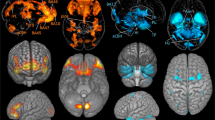Abstract
Previous postmortem anatomical studies have demonstrated differences between male and female in the size and shape of the splenium of the corpus callosum. The current study using the magnetic resonance imager compares the corpus callosum in 20 transsexuals and 40 controls to determine if the anatomic variance is related to anatomic sex or gender identity. No statistical differences were found in the cross-sectional areas of the entire corpus callosum, regardless of genetic sex or gender. However, the genetic males did have a larger whole-brain cross-sectional area. Also, even though there was a wide range of differences in shape and size in the splenium, the study found no significant differences between the sexes or between transsexual patients of either sex and the controls.
Similar content being viewed by others
References
Bean, R. B. (1906). Some racial peculiarities of the Negro brain.Am. J. Anat. 5: 353–432.
Crovitz, H. F., and Zener, C. (1962). A group test for assessing hand and eye dominance.Am. J. Psychol. 75: 271–276.
Dawe, S., and Corballis, M. C. (1980). The influence of gender on handedness and head turn in auditory asymmetries.Neuropsychologia 24: 857–862.
de Lacoste-Utamsing, P., and Holloway, R. L. (1982). Sexual dimorphism in the human corpus callosum.Science 216: 1431–1432.
Dorner, G., Rohde, W., Seidel, K., Haas, W., and Schott, G. (1976). On the evocability of a positive oestrogen feedback action on LH secretion in transsexual men and women.Endokrinologie 67: 20–25.
Flor-Henry, H. P. (1978). Gender, hemispheric specialization and psychopathology.Soc. Sci. Med. 12: 155–162.
Goh, H. H., Ratnam, S. S., and London, D. R. (1984). The feminization of gonadotropin responses in intact male transsexuals.Clin. Endocrinol. 20: 591–596.
Goh, H. H., Wong, P. C., and Ratnam, S. S (1985). Effects of sex steroid on the positive estrogen feedback mechanism in intact women and castrate men.J. Clin. Endocrinol. Metab. 61: 1158–1164.
Gooren, L. (1986). The neuroendocrine response to luteinizing hormone to estrogen administration in heterosexual, homosexual and transsexual subjects.J. Clin. Endocrinol. Metab. 63: 583–588.
Gooren, L. J. G., Rao, B. R., van Kessel, H., and Harmsen-Louman, W. (1984). Estrogen positive feedback on LH secretion in transsexuality.Psychoneuroendocrinology 9: 249–259.
Holloway, R. L. (1980). Within-species brain body weight variability: A reexamination of the Danish data and other primate species.Am. J. Phys. Anthropol. 53: 109–121.
Holloway, R. L., and de Lacoste, M. C. (1986). Sexual dimorphism in the human corpus callosum: an extension and replication study.Hum. Neurobiol. 5: 87–91.
McGlone, J. (1978). Sex differences in functional brain asymmetry.Cortex 14: 122–128.
McGlone, J. (1980). Sex differences in human brain asymmetry: a critical survey.Behav. Brain Sci. 3: 215–263.
McGlone, J., and Kertesz, A. (1973). Sex differences in cerebral processing of visuospatial tasks.Cortex 9: 313–320.
Meyer-Bahlburg, H. F. (1982). Hormones and psychosexual differentiation: Implications for the management of intersexuality, homosexuality, and transsexuality.Clin. Endocrinol. Metab. 11: 681–701.
Nasrallah, H., Andreasen, N. C., Coffman, J. A., Olson, S. C., Dunn, V. D., Ehrhardt, J. C., and Chapman, S. M. (1986). A controlled magnetic resonance imaging study of corpus callosum thickness in schizophrenia.Biol. Psychiat. 21: 274–282.
Pauly, I. B. (1985). Gender identity disorder. In Farber, M. (ed.),Human Sexuality: Psychosexual Effects of Disease McMillan, New York, pp. 295–316.
Swaab, D. F., Roozendaal, B., Ravid, R., Velis, D. N., Gooren, L., and Williams, R. S. (1987). Suprachiasmatic nucleus in aging, Alzheimer's disease, transsexuality and Prader-Willi syndrome.Prog. Brain Res. 72: 301–310.
Walker, P. A., Berger, J. C., Green, R., Laub, D. R., Reynolds, C. L., and Wollman, L. (1985). Standards of care: The hormonal and surgical sex reassignment of gender dysphoric persons.Arch. Sex. Behav. 14: 79–90.
Witelson, S. F. (1985). The brain connection: the corpus callosum larger in left handers.Science 229: 665–668.
Witelson, S. F. (1986). Wires of the mind: Anatomical variation in the corpus callosum in relation to hemispheric specialization and integration. In Lepore, F., Ptito, M. and Jasper, H. H. (eds.),Two Hemispheres — One Brain: Function of the Corpus Callosum Alan R. Liss, New York, pp. 117–137.
Author information
Authors and Affiliations
Rights and permissions
About this article
Cite this article
Emory, L.E., Williams, D.H., Cole, C.M. et al. Anatomic variation of the corpus callosum in persons with gender dysphoria. Arch Sex Behav 20, 409–417 (1991). https://doi.org/10.1007/BF01542620
Issue Date:
DOI: https://doi.org/10.1007/BF01542620




